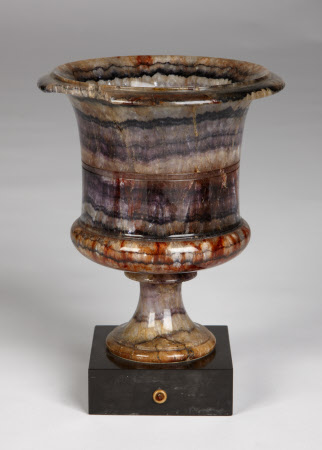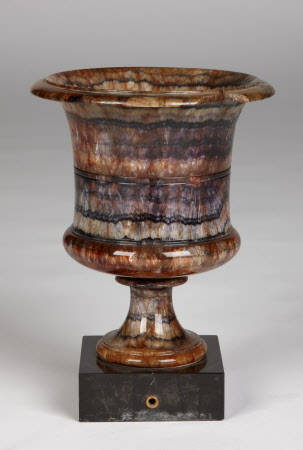A pair of Blue John campana urns
Category
Objets de vertu
Date
circa 1760 - circa 1820
Materials
Blue John, black marble
Measurements
240 x 100 x 100 mm
Place of origin
Derbyshire
Order this imageCollection
Kedleston Hall, Derbyshire
NT 109107
Summary
Blue John and black marble, possibly Ashford black marble, a pair of Blue John campana urns, mounted on square black marble bases, British (Derbyshire), c.1760-1820, adapted as lampshades in the 20th century.
Full description
Blue John is a rare semi-precious fluorite which crystalises in bands of purple, blue and yellow. Its distinctive colouring and light-reflecting qualities made it a highly-prized commodity in the late 18th and 19th centuries, especially as its only known source in the United Kingdom is Derbyshire. Mined from two caverns near Castleton and the now abandoned Old Tor Mine on Winnats Pass, one of the earliest recorded decorative uses of Blue John was at Kedleston Hall, where Robert Adam chose to inlay a panel of it in the State Bedchamber fireplace (c. 1768; NT 107960). Derby marble masons Richard Brown & Sons made the fireplace to Adam's designs, obtaining their Blue John from a Mr Bradbury of Castleton (Ford 2000, p. 56). Adam probably ordered the production of other Blue John ornaments for Kedleston through local masons, possibly Richard Brown & Sons, as Brown is attributed to a pair of Blue John obelisks in the Family Corridor (NT 109102). See also a pair of Blue John columns (NT 109103), obelisks (NT 109102, 109105), and an urn (NT 109104, originally in a pair). Alice Rylance-Watson March 2019
Provenance
Gifted to the National Trust in 1986 by Francis Curzon, 3rd Viscount Scarsdale (1924-2000).
Credit line
Kedleston Hall, The Scarsdale Collection (acquired with the help of the National Heritage Memorial Fund and transferred to The National Trust in 1987)
Marks and inscriptions
n
References
Ford 2000: Trevor D. Ford, Derbyshire Blue John, Derbyshire, 2000, pp. 56-7.


